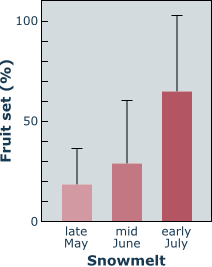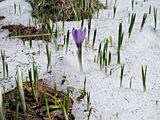A matter of timing?
Variation in phenology
Alpine floras are famous for their flower richness. In temperate alpine regions, this is because of the short growing season causing very pronounced seasonal peaks of flowering. In the central Himalayas more than 70 % of all species flower during mid July, or in the alpine zones of temperate mountains by the end of July. In the tropics, too, pronounced seasonal cycles can narrow the flowering period for most species to a few months.
Snow cover as a limit for reproduction
Snow cover and time of snowmelt have been suggested as the principal factors controlling the distribution, the flowering phenology and seed set in alpine species. This control may be effected directly by determining the length of the growing season or indirectly by regulating soil moisture or low soil temperature affected by melting water.
| Number of species in plots differing in their snowfree period (Hokkaido, northern Japan, 1900 m) | |||||
| Plot | Snowfree period (days) | Total no. of species | Shrubs | Forbs | Graminoids |
| A | 100 | 36 | 12 | 16 | 8 |
| B | 85 | 33 | 10 | 13 | 10 |
| C | 70 | 24 | 8 | 9 | 7 |
| D | 60 | 21 | 6 | 9 | 6 |
| E | 50 | 5 | 2 | 0 | 3 |




